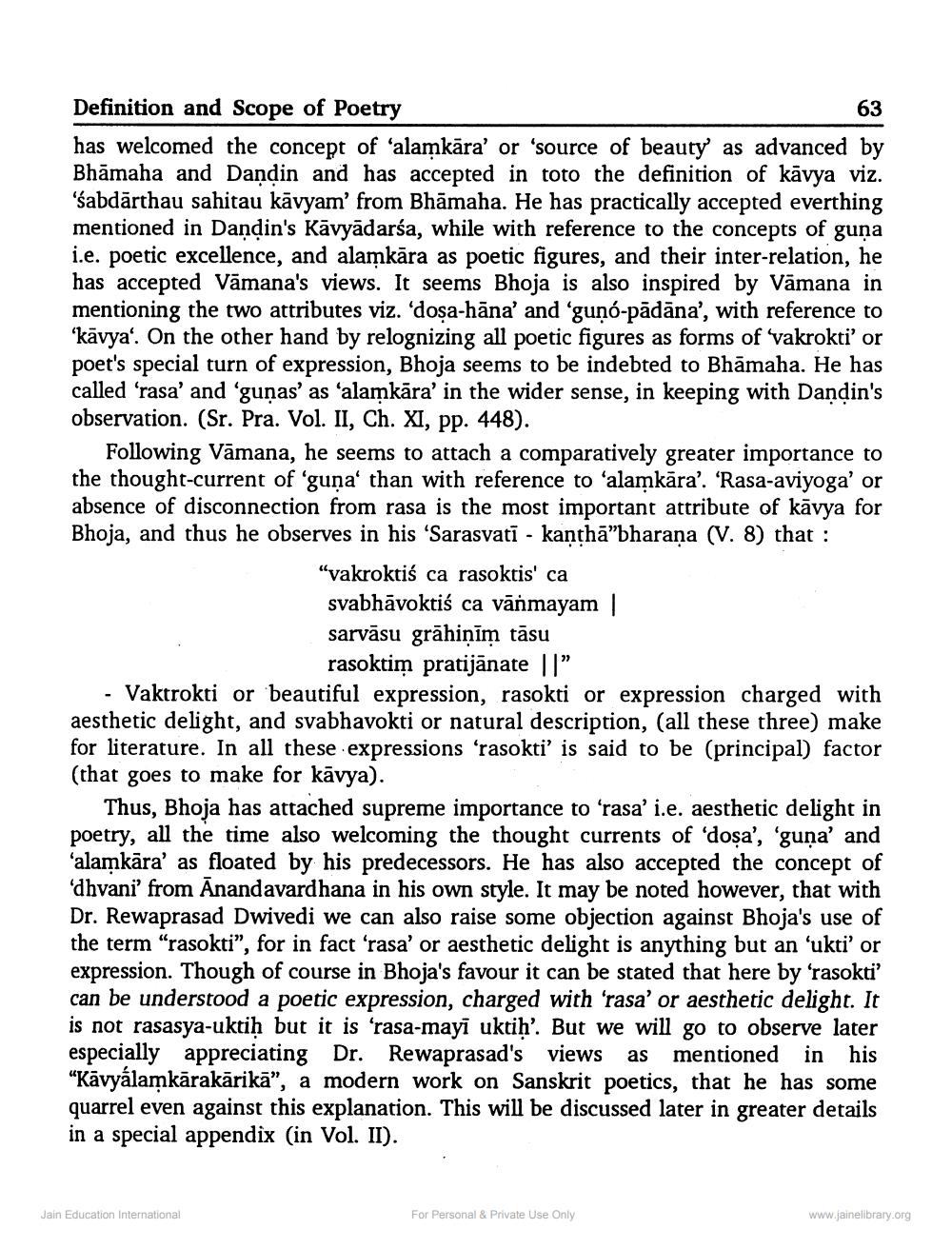________________
Definition and Scope of Poetry
63
has welcomed the concept of 'alamkara' or 'source of beauty as advanced by Bhāmaha and Dandin and has accepted in toto the definition of kavya viz. 'sabdarthau sahitau kavyam' from Bhamaha. He has practically accepted everthing mentioned in Dandin's Kävyädarśa, while with reference to the concepts of guna i.e. poetic excellence, and alamkāra as poetic figures, and their inter-relation, he has accepted Vamana's views. It seems Bhoja is also inspired by Vamana in mentioning the two attributes viz. ‘doṣa-hāna' and 'guṇó-pādāna', with reference to 'kavya'. On the other hand by relognizing all poetic figures as forms of 'vakrokti' or poet's special turn of expression, Bhoja seems to be indebted to Bhāmaha. He has called 'rasa' and 'gunas' as 'alamkara' in the wider sense, in keeping with Dandin's observation. (Sr. Pra. Vol. II, Ch. XI, pp. 448).
Following Vamana, he seems to attach a comparatively greater importance to the thought-current of 'guna' than with reference to 'alamkara'. 'Rasa-aviyoga' or absence of disconnection from rasa is the most important attribute of kavya for Bhoja, and thus he observes in his 'Sarasvati - kantha"bharana (V. 8) that :
"vakroktiś ca rasoktis' ca svabhāvoktiś ca vanmayam | sarvāsu grāhiṇīm tāsu
rasoktim pratijānate ||"
Vaktrokti or beautiful expression, rasokti or expression charged with aesthetic delight, and svabhavokti or natural description, (all these three) make for literature. In all these expressions 'rasokti' is said to be (principal) factor (that goes to make for kāvya).
Thus, Bhoja has attached supreme importance to 'rasa' i.e. aesthetic delight in poetry, all the time also welcoming the thought currents of 'dosa', 'guna' and 'alamkara' as floated by his predecessors. He has also accepted the concept of 'dhvani' from Anandavardhana in his own style. It may be noted however, that with Dr. Rewaprasad Dwivedi we can also raise some objection against Bhoja's use of the term "rasokti", for in fact 'rasa' or aesthetic delight is anything but an 'ukti' or expression. Though of course in Bhoja's favour it can be stated that here by 'rasokti' can be understood a poetic expression, charged with 'rasa' or aesthetic delight. It is not rasasya-uktiḥ but it is 'rasa-mayī uktiḥ'. But we will go to observe later especially appreciating Dr. Rewaprasad's views as mentioned in his "Kāvyalamkārakārikā", a modern work on Sanskrit poetics, that he has some quarrel even against this explanation. This will be discussed later in greater details in a special appendix (in Vol. II).
Jain Education International
For Personal & Private Use Only
www.jainelibrary.org




